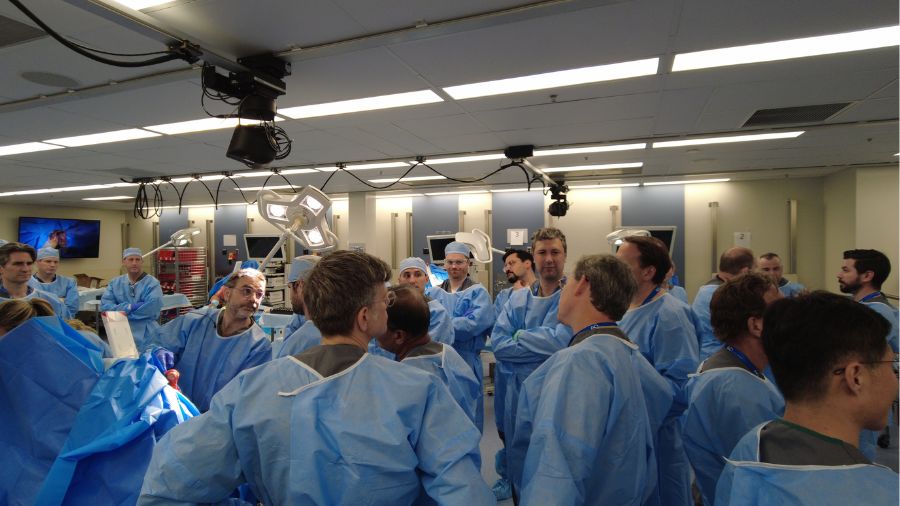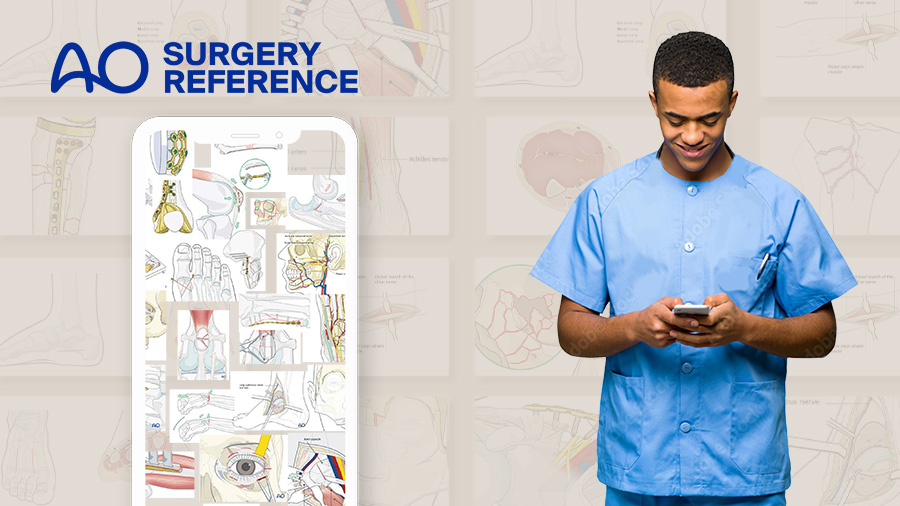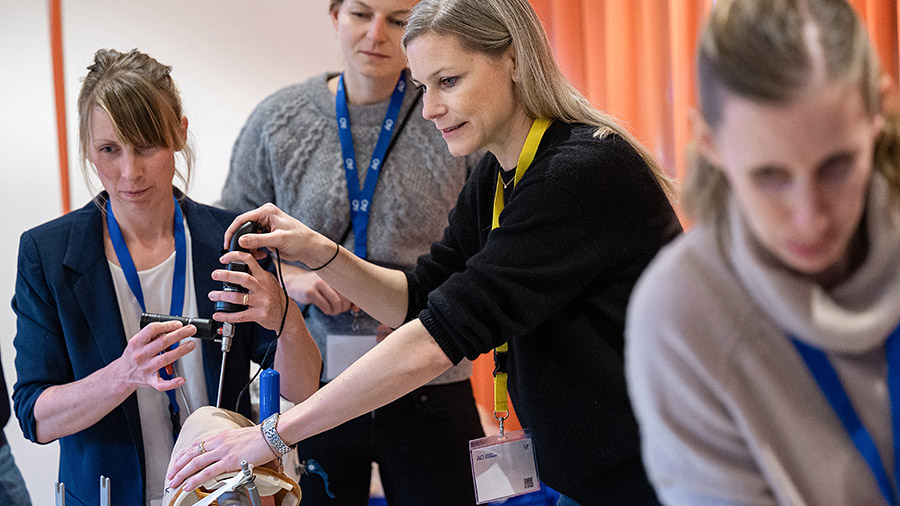Biceps tenodesis: Does it matter where you put it?
BY AMON FERRY, MD, WITH SPECIAL THANKS TO MAIO CHEN FOR HER RESEARCH SUPPORT

Long head of the biceps tendon (LHBT) pathology is a frequent source of shoulder pain. The treatment of which varies based on the type and degree of injury. When it comes to surgical management of isolated LHBT pathology, there are several options which are frequently debated. When a biceps tenodesis is performed does the location of reattachment affect the outcome of the surgery? We looked at recent clinical evidence.
Read the evidence and explore all upcoming AO Sports shoulder courses.
Disclaimer: The article represents the opinion of individual authors exclusively and not necessarily the opinion of AO or its clinical specialties.
With so many different ways to treat long head biceps tendon (LHBT) pathology, I often find myself asking: “Does it really matter?” Most of us will agree that the LHBT can be a pain generator either primarily due to pathology of the tendon itself or secondarily due to its relationship with the superior labrum. Although the function of the LHBT is debatable, it has been demonstrated to be much less critical for the proper functioning of the arm than the short head of biceps tendon (SHBT). To better understand the correct treatment for LHBT related symptoms we need to consider how we treat it…or do we?
Making a diagnosis in LHBT tendinopathy
Patients who suffer from LHBT tendinopathy often experience anterior shoulder pain radiating into the biceps muscle belly that can be worse with extension and external rotation of the shoulder. The diagnosis can be made based on history and physical exam and is confirmed with an MRI. Because there are several pain generators in the shoulder it is important to also evaluate for injuries to other structures such as the rotator cuff or labrum.
Treatment methods for long head biceps tendon injuries
In cases of isolated long head biceps tendon injuries, surgical treatment involves either a tenotomy or tenodesis. Surgical tenotomy is simple and cost effective but has been shown to have a high rate of popeye deformity. Additionally, active patients often experience pain and cramping of the biceps muscle, particularly with active forearm rotation. In select patients, particularly those with concerns of cosmesis or manual laborers, LBHT pathology will be best treated with a tenodesis.
When performing a tenodesis there are three locations where the tendon can be reattached: intra-articular (at the top of the groove), suprapectoral (above the pectoralis major tendon) or subpectoral (below the pectoralis major tendon). Intra-articular and suprapectoral tenodeses are frequently performed arthroscopically, whereas a subpectoral tenodesis is performed through a mini-open approach.
When treating intrinsic biceps pathology does the position of the tenodesis matter? Could the abnormal tendon left in the bicipital groove with a Intra-articular tenodesis lead to more groove pain and worse patient reported outcomes?
The state of the research
In an attempt to provide answers to these questions, we recently reviewed the available literature on the matter. As surgical techniques and available implants have improved over recent years, we narrowed the focus to include articles published within the past five years. We prioritized meta-analyses of comparative studies, while also looking at relevant individual comparative studies and review articles.
A network meta-analysis by Anil et al(1) analyzed 22 studies published between 2002 and 2018 to compare arthroscopic tenotomy, arthroscopic suprapectoral tenodesis, open subpectoral tenodesis and arthroscopic intracuff tenodesis. It found that surgical treatment of isolated biceps tendon pathology with open or arthroscopic tenodesis resulted in more favorable functional scores and less frequent Popeye deformity when compared to tenotomy. Additionally, arthroscopic intracuff tenodesis resulted in a significantly higher incidence of postoperative bicipital groove pain.
Van Deurzen et al(2) performed a meta-analysis of seven studies published between 2014 and 2019 comparing suprapectoral and subpectoral tenodesis. They found that although the subpectoral group had a significantly better mean American Shoulder and Elbow Surgeons (ASES) score, the results did not meet the criteria for clinical relevance. No differences were found between groups regarding Constant score, visual analog pain score, Popeye deformity or persistent bicipital pain.
A study by Belk et al(3) analyzed eight studies from between 2014 and 2020 that looked at differences in the clinical outcomes of suprapectoral and subpectoral tenodesis. The researchers concluded that there were no significant differences in patient reported outcomes, postop pain, range of motion, and Popeye deformity.
Forsythe et al(4) published a level 1, randomized controlled study of 75 patients who underwent either an arthroscopic suprapectoral or an open subpectoral tenodesis, regardless of concomitant pathology and/or treatment. No significant differences were found in patient reported outcomes, functional outcomes, or complication rates between the groups up to 12 months following the procedure.
In conclusion, based on a broad review of the current literature, when compared to tenotomy, LHBT tenodesis leads to more favorable functional scores and a lower incidence of Popeye deformity, but clinically relevant differences based on tenodesis location have not been shown.
About the author:
References and further reading:
- Anil U, Hurley ET, Kingery MT, et al. Surgical treatment for long head of the biceps tendinopathy: a network meta-analysis. J Shoulder Elbow Surg. 2020 Jun;29(6):1289-1295.
- van Deurzen DFP, Gurnani N, Alta TDW, et al. Suprapectoral versus subpectoral tenodesis for Long Head Biceps Brachii tendinopathy: A systematic review and meta-analysis. Orthop Traumatol Surg Res. 2020 Jun;106(4):693-700.
- Belk JW, Thon SG, Hart J, et al. Subpectoral versus suprapectoral biceps tenodesis yields similar clinical outcomes: a systematic review. J isakos. 2021 May 20.
- Forsythe B, Zuke W, Agarwalla A, Puzzitiello R, Garcia G, Cvetanovich G, Yanke A, Verma N, Romeo A. Arthroscopic Suprapectoral and Open Subpectoral Biceps Tenodeses Produce Similar Outcomes: A Randomized Prospective Analysis. Arthroscopy. 2020 Jan: 36(1):23-32.
You might also be interested in:
AO Sports gold-standard education
AO Sports provides gold-standard AO education on the surgical treatment of sports injuries and other soft-tissue conditions around the joint, on knee and shoulder injuries and deformities.
AO Surgery Reference
A powerful online resource for the management of a vast variety of fractures. AO Surgery Reference is based on current clinical principles, practices, and available evidence, designed to support your day-to-day treatment planning, learning, and teaching.
AO Course Finders
Find more accredited and high quality educational activities from AO across different pathologies. Explore your next learning activity in your region or worldwide.








